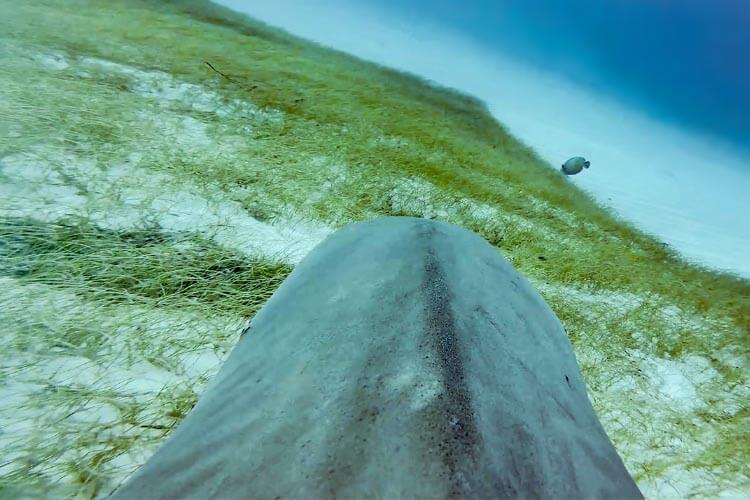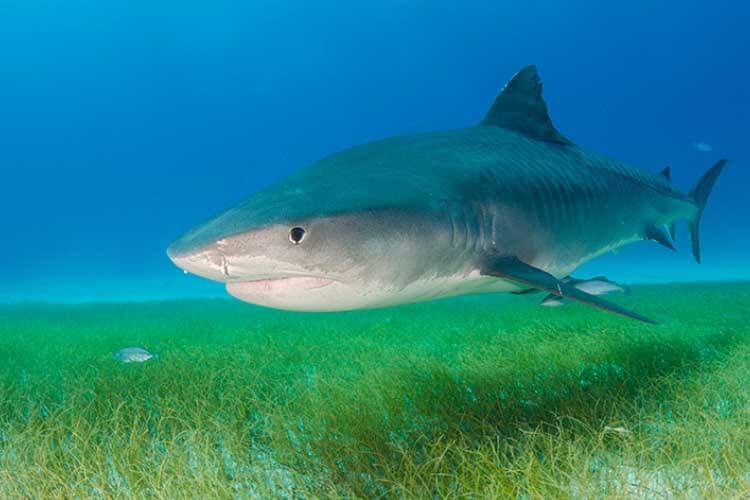
The largest seagrass ecosystem in the world has been discovered and mapped in The Bahamas – thanks to the help of the local tiger shark population, according to a new study.
The study, published in the journal Nature Communications, details the researchers’ innovative approach of using camera tags to track the movements of tiger sharks over seagrass meadows, which helped the scientists map and measure the size of Bahamian seagrass meadows for the first time – an area estimated to be up to 92,000 sq km.
Seagrass is one of the most important – but often most overlooked – ecosystems in the world. They are habitats, nurseries and food sources for many different species, perform an effective coastal barrier against storms, and serve as one of the largest environments for carbon sequestration – known as blue carbon – in the world, up to 35 times more effective than rainforests.

Much of the world’s seagrass has been lost over the last 50 years, but quantitatively accurate measurements of the remaining areas of seagrass are difficult to obtain. Seagrass meadows cannot be mapped from space, as they yield signals similar to seaweed, and are often covered by carbonate deposits, which return a signal similar to that of bare sand.
The Bahamas has been a world leader in shark protection for more than 30 years, with tiger sharks (Galeocerdo cuvier) being a protected species for more than a decade. As part of that protection, Beneath The Waves (BTW), an ocean NGO and research institute, has been monitoring the behaviour of the species to determine how marine protected areas could be improved and expanded in order to ‘optimise’ shark conservation.
In 2019, BTW’s lead scientist and CEO, Dr Austin Gallagher, began attaching camera tags to tiger sharks throughout The Bahamas, which recorded the sharks swimming over dense and expansive seagrass meadows.
‘This is when the lightbulb first went off, so to speak,’ said Gallagher, who showed the videos to collaborator and senior co-author on the study, Professor Carlos Duarte of Saudi Arabia’s King Abdullah University of Science and Technology (KAUST).
You may also like
‘The marine ecosystem in The Bahamas, which two decades ago I was able to admire in awe from a commercial plane, contains the largest sand banks in the world, which are shallow habitats perfectly suited to growing seagrass,’ said Duarte. ‘We thought that The Bahamas likely had an extensive seagrass ecosystem, but the true spatial estimate had never been properly quantified because surveying this vast area remains challenging.’
In order to map the total area covered by seagrass in The Bahamas, the team performed their own remote sensing analysis and integrated previous estimates from existing satellite images, which were then paired with more than 2,400 diver seagrass surveys. Working with tiger sharks allowed the researchers to greatly extend the range of their seafloor maps.
‘Research led by Beneath The Waves had shown that tiger sharks spend about 72 per cent of their time patrolling seagrass beds, which can be observed by the 360° cameras we deployed on the sharks,’ said Dr Duarte. ‘This provided an opportunity to expand ground-truthing across the vast, challenging depths of the Bahamas Banks, as tiger sharks cover about 70 km in one day and are not constrained, as human divers are, to shallow depths.’
The additional survey material provided by the tiger sharks raised the estimates of the area of seagrass habitat across The Bahama Banks from a minimum of 66,000 sq km to 92,000 sq km. Collecting sediment cores from the seagrass ecosystem during the study revealed that The Bahamas likely holds up to 25 per cent of the global stock of seagrass-based blue carbon.

“The innovative work done by Beneath The Waves, in partnership with Bahamians, to map our country’s vast seagrass meadows, represents extraordinary scientific progress, and will make a very significant contribution to our national development and security,’ said Prime Minister of The Bahamas, Philip Brave Davis. ‘The Bahamas may be in the top of rankings on climate vulnerability, but we now have evidence that we top the list of the world’s blue carbon hotspots, too – which means our seagrasses can play a critical role in generating the resources we need to transition to renewable energy and to adapt and become more resilient to the changing climate.’
‘This discovery should give us hope for the future of our oceans,’ said Dr Gallagher. ‘It also demonstrates how everything is connected. Because tiger sharks had been protected in The Bahamas for many years, we were able to study and monitor the ancient processes these animals had been engaged in for millennia. The sharks led us to the seagrass ecosystem in The Bahamas, which we now know is likely the most significant blue carbon sink on the planet.
‘If protected, these seagrasses can play a crucial role in slowing the climate emergency,’ he added, ‘as the world moves to deploy a diverse range of strategies to capture carbon from the atmosphere.’
The complete paper, ‘Tiger sharks support the characterization of the world’s largest seagrass ecosystem’, by Gallagher, AJ, Brownscombe, JW, Alsudairy, NA et al is published by Nature Communications.
- Conception liveaboard fire captain appeals manslaughter verdict - 5 December 2025
- New global dive-travel platform Scubago set to launch in 2026 - 3 December 2025
- DIVE’s Biggest Shots of 2025 - 1 December 2025


